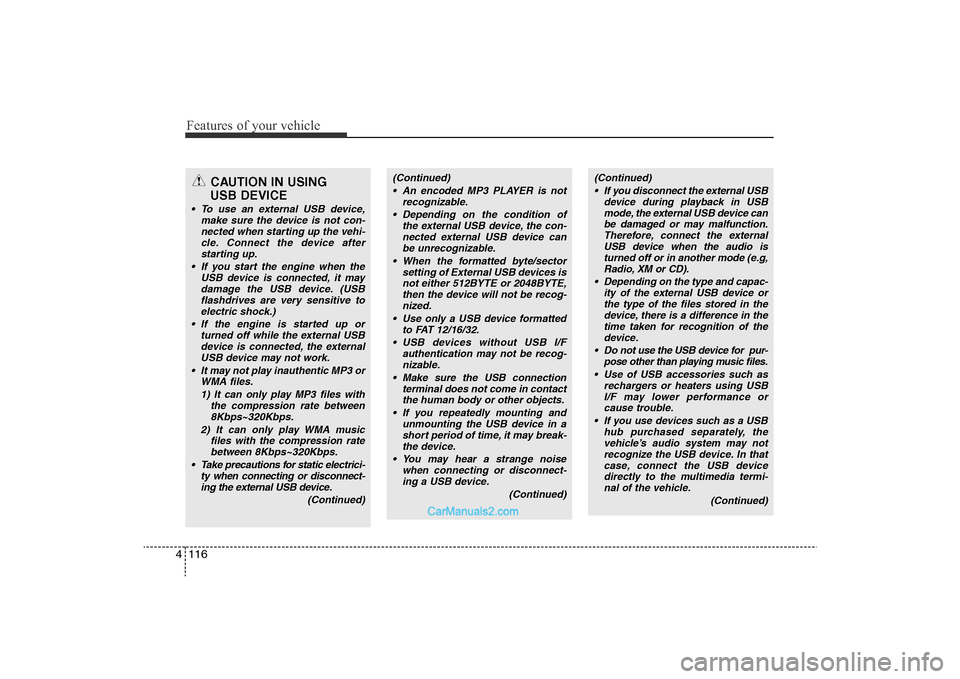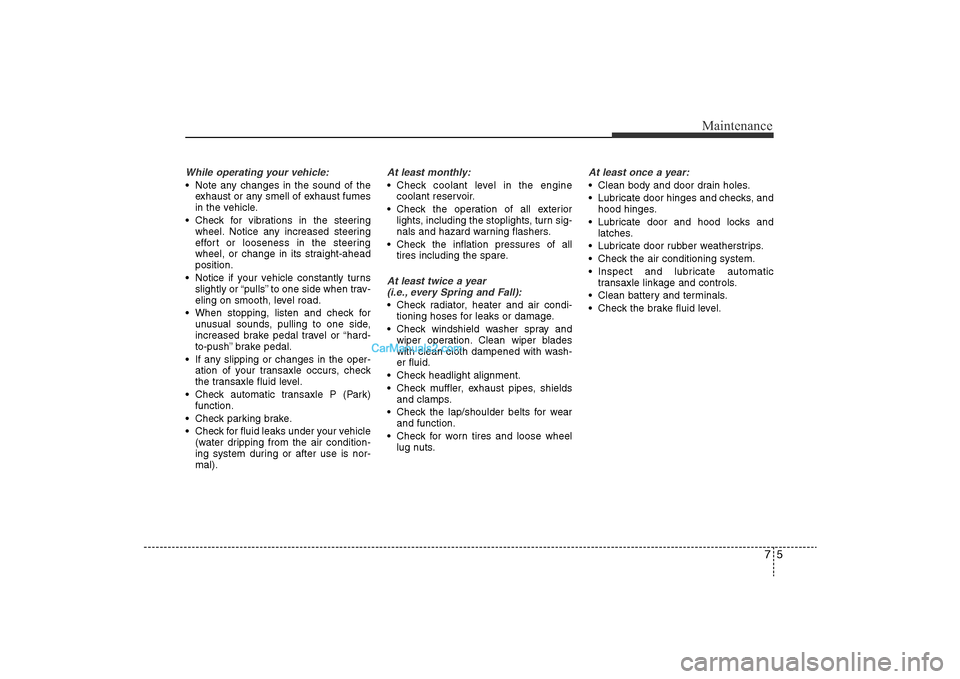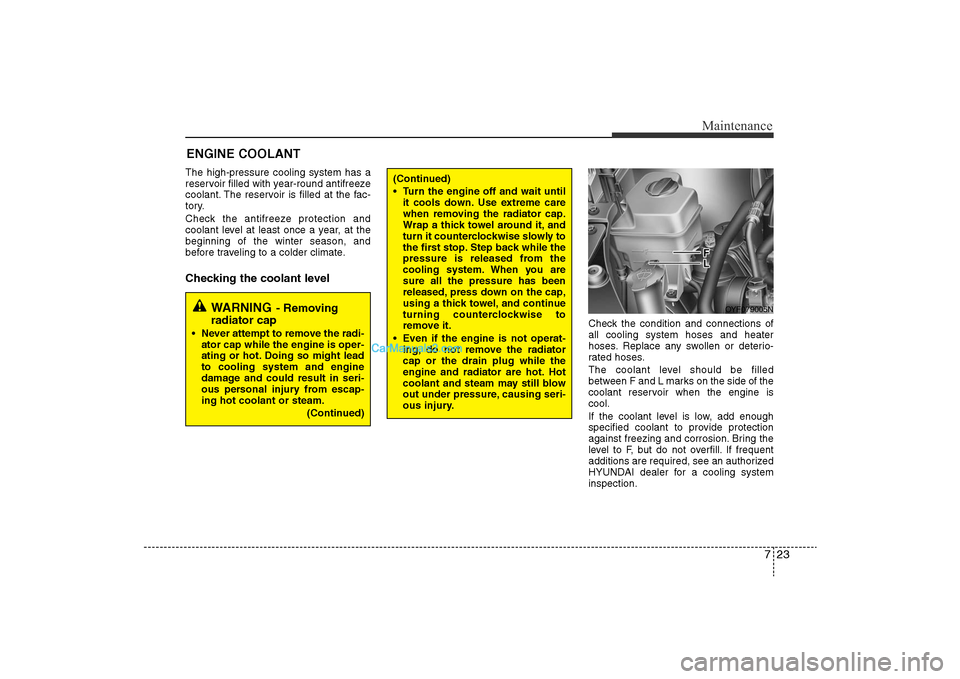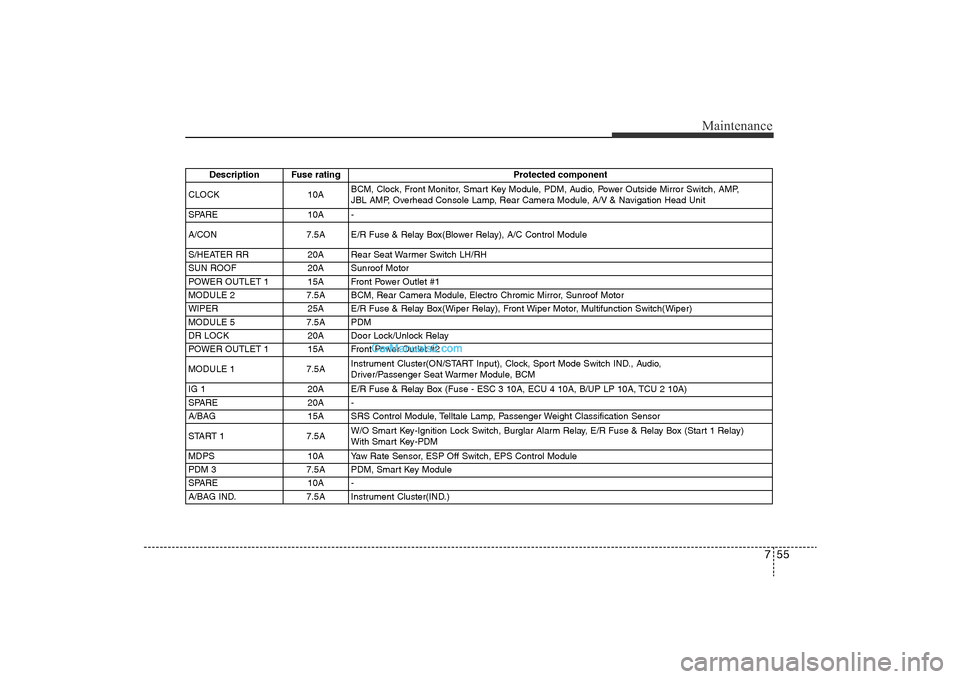2011 Hyundai Sonata heater
[x] Cancel search: heaterPage 196 of 380

Features of your vehicle116
4
CAUTION IN USING
USB DEVICE
• To use an external USB device,
make sure the device is not con-nected when starting up the vehi- cle. Connect the device afterstarting up.
• If you start the engine when the USB device is connected, it maydamage the USB device. (USBflashdrives are very sensitive to electric shock.)
• If the engine is started up or turned off while the external USBdevice is connected, the externalUSB device may not work.
• It may not play inauthentic MP3 or WMA files.
1) It can only play MP3 files with the compression rate between8Kbps~320Kbps.
2) It can only play WMA music files with the compression ratebetween 8Kbps~320Kbps.
• Take precautions for static electrici- ty when connecting or disconnect-ing the external USB device.
(Continued)
(Continued)• An encoded MP3 PLAYER is not recognizable.
• Depending on the condition of the external USB device, the con-nected external USB device can be unrecognizable.
• When the formatted byte/sector setting of External USB devices isnot either 512BYTE or 2048BYTE,then the device will not be recog-nized.
• Use only a USB device formatted to FAT 12/16/32.
• USB devices without USB I/F authentication may not be recog-nizable.
• Make sure the USB connection terminal does not come in contactthe human body or other objects.
• If you repeatedly mounting and unmounting the USB device in ashort period of time, it may break-the device.
• You may hear a strange noise when connecting or disconnect-ing a USB device.
(Continued)
(Continued)• If you disconnect the external USB device during playback in USBmode, the external USB device canbe damaged or may malfunction. Therefore, connect the externalUSB device when the audio is turned off or in another mode (e.g,Radio, XM or CD).
• Depending on the type and capac- ity of the external USB device orthe type of the files stored in the device, there is a difference in thetime taken for recognition of the device.
• Do not use the USB device for pur- pose other than playing music files.
• Use of USB accessories such as rechargers or heaters using USBI/F may lower performance orcause trouble.
• If you use devices such as a USB hub purchased separately, thevehicle’s audio system may notrecognize the USB device. In that case, connect the USB devicedirectly to the multimedia termi- nal of the vehicle.
(Continued)
YF HMA 4-104~(AUDIO).QXP 12/24/2009 5:21 PM Page 116
Page 293 of 380

75
Maintenance
While operating your vehicle:• Note any changes in the sound of theexhaust or any smell of exhaust fumes
in the vehicle.
• Check for vibrations in the steering wheel. Notice any increased steering
effort or looseness in the steering
wheel, or change in its straight-ahead
position.
• Notice if your vehicle constantly turns slightly or “pulls” to one side when trav-
eling on smooth, level road.
• When stopping, listen and check for unusual sounds, pulling to one side,
increased brake pedal travel or “hard-
to-push” brake pedal.
• If any slipping or changes in the oper- ation of your transaxle occurs, check
the transaxle fluid level.
• Check automatic transaxle P (Park) function.
• Check parking brake.
• Check for fluid leaks under your vehicle (water dripping from the air condition-
ing system during or after use is nor-
mal).
At least monthly:• Check coolant level in the enginecoolant reservoir.
• Check the operation of all exterior lights, including the stoplights, turn sig-
nals and hazard warning flashers.
• Check the inflation pressures of all tires including the spare.At least twice a year (i.e., every Spring and Fall):• Check radiator, heater and air condi- tioning hoses for leaks or damage.
• Check windshield washer spray and wiper operation. Clean wiper blades
with clean cloth dampened with wash-
er fluid.
• Check headlight alignment.
• Check muffler, exhaust pipes, shields and clamps.
• Check the lap/shoulder belts for wear and function.
• Check for worn tires and loose wheel lug nuts.
At least once a year:• Clean body and door drain holes.
• Lubricate door hinges and checks, andhood hinges.
• Lubricate door and hood locks and latches.
• Lubricate door rubber weatherstrips.
• Check the air conditioning system.
• Inspect and lubricate automatic transaxle linkage and controls.
• Clean battery and terminals.
• Check the brake fluid level.
YF HMA 7.QXP 11/25/2009 1:45 PM Page 5
Page 311 of 380

723
Maintenance
The high-pressure cooling system has a
reservoir filled with year-round antifreeze
coolant. The reservoir is filled at the fac-
tory.
Check the antifreeze protection and
coolant level at least once a year, at the
beginning of the winter season, and
before traveling to a colder climate.Checking the coolant level
Check the condition and connections of
all cooling system hoses and heater
hoses. Replace any swollen or deterio-
rated hoses.
The coolant level should be filled
between F and L marks on the side of the
coolant reservoir when the engine is
cool.
If the coolant level is low, add enough
specified coolant to provide protection
against freezing and corrosion. Bring the
level to F, but do not overfill. If frequent
additions are required, see an authorized
HYUNDAI dealer for a cooling system
inspection.
OYF079005N
(Continued)
• Turn the engine off and wait untilit cools down. Use extreme care
when removing the radiator cap.
Wrap a thick towel around it, and
turn it counterclockwise slowly to
the first stop. Step back while the
pressure is released from the
cooling system. When you are
sure all the pressure has been
released, press down on the cap,
using a thick towel, and continue
turning counterclockwise to
remove it.
• Even if the engine is not operat- ing, do not remove the radiator
cap or the drain plug while the
engine and radiator are hot. Hot
coolant and steam may still blow
out under pressure, causing seri-
ous injury.
ENGINE COOLANT
WARNING
- Removing
radiator cap
• Never attempt to remove the radi-
ator cap while the engine is oper-
ating or hot. Doing so might lead
to cooling system and engine
damage and could result in seri-
ous personal injury from escap-
ing hot coolant or steam.
(Continued)
YF HMA 7.QXP 11/25/2009 1:45 PM Page 23
Page 342 of 380

Maintenance54
7Instrument panel (Driver’s side fuse panel)
Description Fuse rating Protected component
P/SEAT DRI 30A Driver Manual Switch
AMP 30A AMP, JBL AMP
TRUNK 10A Trunk Lid Relay, Trunk Room Lamp, Fuel Filler Door & Trunk Lid Switch
SAFETY POWER
WINDOW 25A Safety Power Window Module
P/WDW ASST 20A Passenger Power Window Switch
P/WDW LH 25A Power Window Main Switch, Rear Power Window Switch LH
SPARE 7.5A -
SPARE 10A -
PDM 2 7.5A FOB Holder, Start Stop Button Switch, PDM, Smart Key Module
MODULE 3 7.5A Key Solenoid, Sport Mode Switch
P/WDW RH 25A Power Window Main Switch, Rear Power Window Switch RH
SPARE 10A -
HTD MIRR 10A Driver/Passenger Power Outside Mirror
P/SEAT ASST 20A -
S/HEATER FRT 15A Driver/Passenger Seat Warmer Module
PDM 25A PDM
ROOM LP (POWER
CONNECTOR) 10AInstrument Cluster, Driver/Passenger Door Lamp, Ignition Key ILL. & Door Warning Switch, BCM,
Tire Pressure Monitoring Module, A/C Control Module, Room Lamp, Front Monitor, Glove Box Lamp,
Data Link Connector, Vanity Lamp LH/RH, Auto Light & Photo Sensor, RF Receiver, Overhead Console
Lamp, Clock
AUDIO (POWER
CONNECTOR) 15A Audio, A/V & Navigation Head Unit
YF HMA 7.QXP 11/25/2009 1:51 PM Page 54
Page 343 of 380

755
Maintenance
Description Fuse rating Protected component
CLOCK 10A BCM, Clock, Front Monitor, Smart Key Module, PDM, Audio, Power Outside Mirror Switch, AMP,
JBL AMP, Overhead Console Lamp, Rear Camera Module, A/V & Navigation Head Unit
SPARE 10A -
A/CON 7.5A E/R Fuse & Relay Box(Blower Relay), A/C Control Module
S/HEATER RR 20A Rear Seat Warmer Switch LH/RH
SUN ROOF 20A Sunroof Motor
POWER OUTLET 1 15A Front Power Outlet #1
MODULE 2 7.5A BCM, Rear Camera Module, Electro Chromic Mirror, Sunroof Motor
WIPER 25A E/R Fuse & Relay Box(Wiper Relay), Front Wiper Motor, Multifunction Switch(Wiper)
MODULE 5 7.5A PDM
DR LOCK 20A Door Lock/Unlock Relay
POWER OUTLET 1 15A Front Power Outlet #2
MODULE 1 7.5A Instrument Cluster(ON/START Input), Clock, Sport Mode Switch IND., Audio,
Driver/Passenger Seat Warmer Module, BCM
IG 1 20A E/R Fuse & Relay Box (Fuse - ESC 3 10A, ECU 4 10A, B/UP LP 10A, TCU 2 10A)
SPARE 20A -
A/BAG 15A SRS Control Module, Telltale Lamp, Passenger Weight Classification Sensor
START 1 7.5A W/O Smart Key-Ignition Lock Switch, Burglar Alarm Relay, E/R Fuse & Relay Box (Start 1 Relay)
With Smart Key-PDM
MDPS 10A Yaw Rate Sensor, ESP Off Switch, EPS Control Module
PDM 3 7.5A PDM, Smart Key Module
SPARE 10A -
A/BAG IND. 7.5A Instrument Cluster(IND.)
YF HMA 7.QXP 11/25/2009 1:51 PM Page 55
Page 344 of 380

Maintenance56
7Engine compartment main fuse panel
Description Fuse rating Protected component
MULTI FUSE B+ 2 60A
I/P Junction Box (Fuse - SUNROOF 20A, DR LCOK 20A, IPS 1 /IPS 4 /IPS 6 /IPS 7 /IPS
9, Power Connector - ROOM LP 10A)
B+ 3 60A I/P Junction Box (Fuse - P/WDW ASST 20A, P/WDW LH 25A, P/WDW RH 25A , TRUNK
10A, S/HEATER FRT 15A, PDM 25A, MODULE 3 7.5A, SAFETY POWER WINDOW 25A,
Power Connector - AUDIO 15A, Power Window Relay)
IGN 1 40A W/O Smart Key - Ignition Switch, With Smart Key - ACC Relay, IG1 Relay
ESC 1 40A ESC Module, Multipurpose Check Connector
RR HTD 40A RR HTD Relay
BLOWER 40A Blower Relay
B+ 4 60A I/P Junction Box (Fuse - P/SEAT DRIV 30A, AMP 30A, PDM 2 7.5A, IPS 2 /IPS 3 /IPS 5
/IPS 8)
MDPS 80A EPS Control Module
FUSE A/CON 10A A/C Control Module (Auto)
B/UP LP 10A Back-up Lamp Switch (M/T), B/UP LP Relay (A/T)
ESC 3 10A ESC Module, Multipurpose Check Connector
TCU 2 10A Vehicle Speed Sensor (M/T), Transaxle Range Switch (A/T), Start2 Relay
ECU 4 10A Stop Lamp Switch, PCM
IGN 2 30A W/O Smart Key - Ignition Switch, Start1 Relay, With Smart Key - Start 1 Relay, IG 2 Relay
EMS 40A EMS Box (Fuse - HORN 15A, ECU 3 10A, ECU 1 30A, F/PUMP 20A)
ESC 2 30A ESC Module, Multipurpose Check Connector
WIPER 10A PCM
RR HTD IND 10A A/C Control Module
AMS 15A Battery Sensor
TCU 1 20A PCM
YF HMA 7.QXP 11/25/2009 1:51 PM Page 56